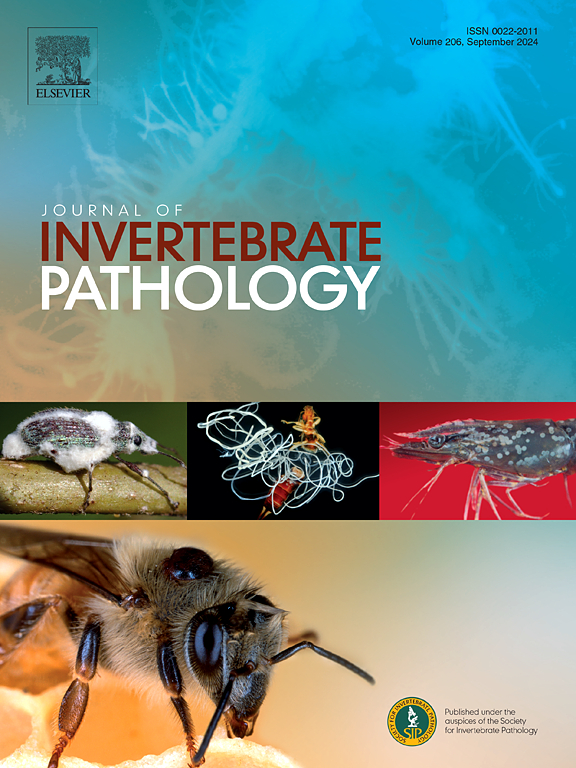Physiological costs of infection by the invasive parasitic copepod Mytilicola intestinalis accumulate across temporal scales in the blue mussel Mytilus edulis
IF 2.4
3区 生物学
Q1 ZOOLOGY
引用次数: 0
Abstract
Exploitation of host resources by parasites can have profound impacts on infected hosts. When prevalence is high parasite infection can even feed back on host population dynamics. Especially when parasites are invasive species, their new native hosts can suffer from exploitation due to a lack of co-evolutionary history. Nevertheless, energetic costs are often subtle at the level of the individual and hard to link to population level effects. Sublethal energetic costs accumulate over time and can in sum be traded off against fitness over longer time scales. To study temporal accumulation of infection costs, we used a series of controlled infection experiments to assess the physiological effects exerted by the invasive parasitic copepod Mytilicola intestinalis on its newly acquired native host, the blue mussel Mytilus edulis in the North Sea, where the parasite can reach prevalences > 70 %. To link short-term physiological responses to long term components of fitness, we combined several methodological approaches measuring changes of physiological traits that act on different time scales. Stable isotope analyses over different seasons and environments revealed a direct consumption of host tissue by M. intestinalis. Tissue repair increased energy demand that could directly be observed in accelerated heartbeat rates, and changes of amino acid metabolism measured by 1H NMR spectroscopy. Although these effects were comparatively small in size, the resulting altered energy budget of the mussel host led to a lower body condition index under controlled laboratory conditions on medium time scales (months) and slower growth in the field over longer time scales (1 year). In combination, our experimental results show that small short-term physiological changes can translate to fitness relevant negative effects on life history traits when integrated across temporal scales.

蓝贻贝(Mytilus edulis)受侵入性寄生桡足动物肠密螺(Mytilicola ininalis)感染的生理代价在时间尺度上积累
寄生虫利用宿主资源对被感染宿主产生深远的影响。当流行率高时,寄生虫感染甚至可以反馈宿主种群动态。特别是当寄生虫是入侵物种时,由于缺乏共同进化的历史,它们的新原生宿主可能会遭受剥削。然而,能量成本在个人层面上往往是微妙的,很难与人口层面的影响联系起来。随着时间的推移,亚致命的能量消耗会累积,总的来说,可以在更长的时间尺度上与健康相权衡。为了研究感染成本的时间积累,我们采用一系列的控制感染实验来评估入侵桡足动物Mytilicola肠子对其新获得的本地宿主北海蓝贻贝Mytilus edulis的生理影响,该寄生虫可以在北海流行。70%。为了将短期生理反应与健康的长期组成部分联系起来,我们结合了几种方法来测量生理特征在不同时间尺度上的变化。不同季节和环境的稳定同位素分析表明,肠芽孢杆菌直接消耗宿主组织。组织修复增加了能量需求,这可以直接观察到心跳加速,以及1H NMR光谱测量的氨基酸代谢变化。尽管这些影响在规模上相对较小,但由此导致的贻贝宿主能量收支的改变,导致在受控的实验室条件下,在中等时间尺度(数月)下,贻贝的身体状况指数较低,在较长时间尺度(1年)下,贻贝在野外的生长较慢。综上所述,我们的实验结果表明,当跨时间尺度整合时,短期的小生理变化可以转化为与适应性相关的生活史性状的负面影响。
本文章由计算机程序翻译,如有差异,请以英文原文为准。
求助全文
约1分钟内获得全文
求助全文
来源期刊
CiteScore
6.10
自引率
5.90%
发文量
94
审稿时长
1 months
期刊介绍:
The Journal of Invertebrate Pathology presents original research articles and notes on the induction and pathogenesis of diseases of invertebrates, including the suppression of diseases in beneficial species, and the use of diseases in controlling undesirable species. In addition, the journal publishes the results of physiological, morphological, genetic, immunological and ecological studies as related to the etiologic agents of diseases of invertebrates.
The Journal of Invertebrate Pathology is the adopted journal of the Society for Invertebrate Pathology, and is available to SIP members at a special reduced price.

 求助内容:
求助内容: 应助结果提醒方式:
应助结果提醒方式:


